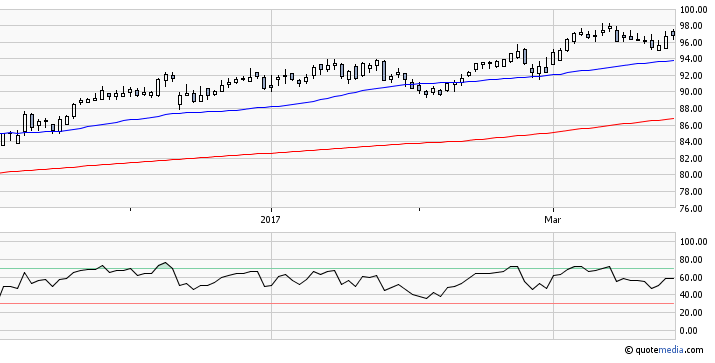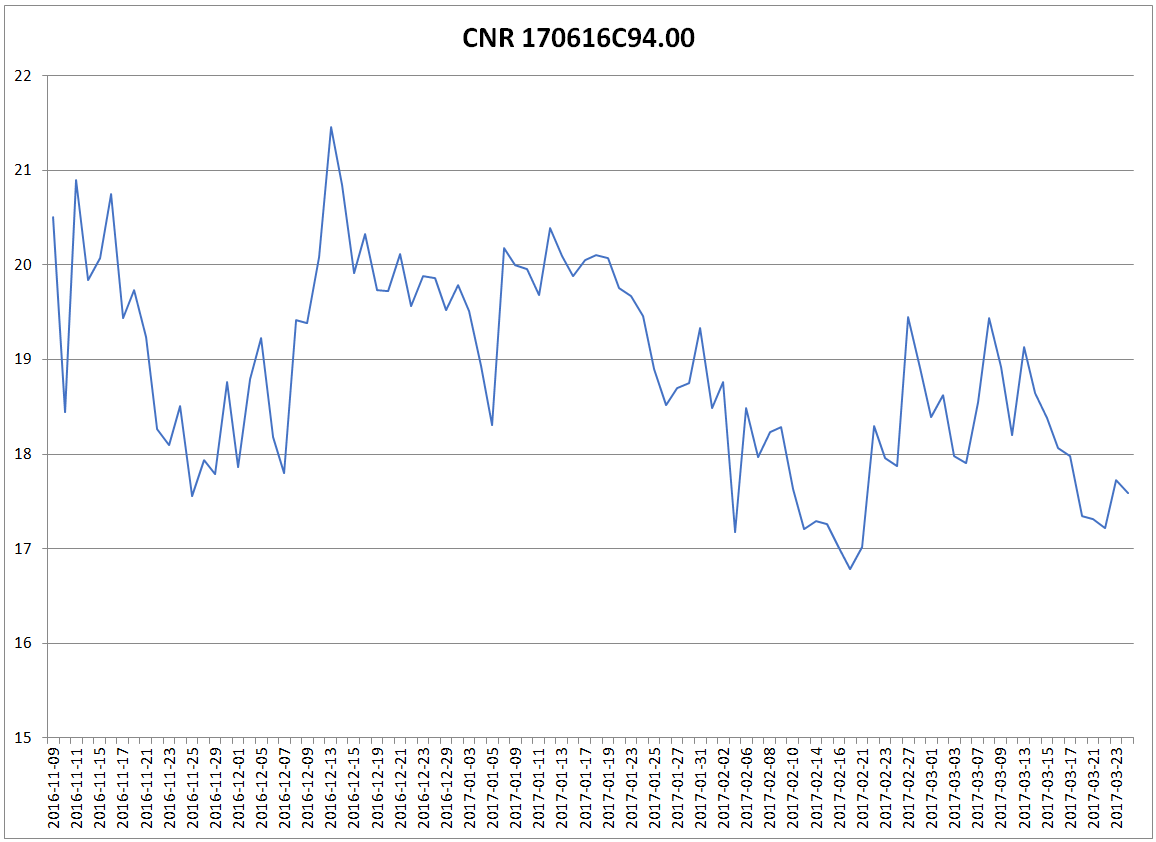The Greeks – Vega

This week, we will look at another Greek variable, called vega. Vega measures the amount that an option contract’s price changes in response to a change in the volatility of the underlying asset. You will recall that an option’s time value is influenced by the time remaining until expiration and by the implied volatility of the option’s price, or premium. A higher implied volatility will increase the option’s time value – and, by extension, the option’s total premium – while a decline in implied volatility will reduce time value. So having positive vega in your portfolio means that you have more to gain from an increase in the implied volatility of your options. In contrast, having negative vega in your portfolio means that you have more to gain from a decrease in the implied volatility of the options. You can increase vega in your portfolio by buying options, and you can produce negative vega in your portfolio by selling options. But since in real life, all the variables – the stock price, the interest rate, the dividend, the volatility and the time value – may be moving at the same time, it is difficult to implement strategies that only take advantage of volatility, without taking into account other variables. So we need to find a way to maximize our chances of success with a strategy that reflects our expectations about potential movements in both the stock price and implied volatility.
Graph of Canadian National Railway Company (CNR) for the period from November 9, 2016 to March 24, 2017

Changes in the implied volatility of the stock option CNR 170616 C 94.00

Data source: the Montréal Exchange
Let us take the example of the Canadian National Railway Company (CNR). Its stock was trading at $96.75 when the markets closed on March 24, 2017. The two above graphs show, first, changes in the price of CNR and, second, changes in the implied volatility of CNR 170616 C 94.00 calls on the stock, for the period from November 11, 2016 to March 24, 2017. (We have chosen these calls for practical reasons, but it would have been preferable to monitor changes in at-the-money options expiring in one month throughout the period.) As we can see, implied volatility is not static; it fluctuates in response to the supply and demand for options generated by investors. The more that investors are interested in buying options, the higher the implied volatility, and vice-versa when they are more interested in selling options. With the small sample at our disposal, we can see that above 20% appears to be a high level of volatility, while below 18% appears to be a relatively low level of volatility. Note that we could draw better conclusions if the data covered a much longer period, but these data are nevertheless adequate for the purposes of this article.
Consider an investor who finds that the implied volatility is too high at the start of November but who, after having analyzed the stock chart, continues to be bullish on CNR. He would want to profit from both a rising stock price and the expected drop in implied volatility. If you are expecting a stock price to rise, the first strategy that may come to mind is to buy call options. However, since a drop in the implied volatility will a negative impact on the price of your options, it would be better to look for another strategy. Writing puts is the ideal strategy for profiting from both an increase in the stock price and a decline in volatility, because when we sell a put, we profit when the share price goes up, but we also profit when the put falls in value because of the drop in implied volatility. So this is a win-win situation.
On November 9, 2016, when CNR was trading at $84.76, an investor could have sold CNR 170317 P 84.00 puts for $3.75 and received $375 on each contract sold. For purposes of comparison, we will also monitor buying calls, CNR 170317 C 84.00, trading at $4.15.
On November 25, 2016, CNR was trading at $90.20, CNR 170317 P 84.00 was at $1.75 and CNR 170317 C 84.00 was at $7.60, while the implied volatility of the stock had just fallen to below 18%. This represents a $2 profit per share on the puts and a $3.45 profit per share on the calls. So we see that the impact of the rise in the stock price was greater than the impact of a lower implied volatility on the calls.
So now, let’s liquidate the positions and re-assess CNR!
The investor is still bullish on the stock and decides to buy the CNR 170317 C 90.00 calls at $3.60. We will compare this to writing the CNR 170317 P 90.00 puts at $3.75.
On December 13, 2016, CNR was trading for $89.86 per share, CNR 170317 C 90.00 was at $3.70 and CNR 170317 P 90.00 was at $4.00, while the implied volatility of the stock had just risen above 21%. In this case, we see that even if the stock has lost value, we have nevertheless maintained the value of our calls with only a slight $0.05 loss per share, while the impact of higher implied volatility on the sale of puts generated a $0.25 loss.
So now, let’s liquidate the positions and re-assess CNR!
Nothing suggests that the trend has changed, so the investor is still bullish on CNR. He therefore decides to write put options to take advantage of both a rise in the price of CNR and the potentially lower implied volatility. He therefore writes CNR 170317 P 90.00 puts at $4.00, which we will compare with buying CNR 170317 C 90.00 calls at $3.70.
On February 2, CNR was trading at $89.70, CNR 170317 C 90.00 was at $1.85 and CNR 170317 P 90.00 was at $2.40, while the implied volatility had just fallen below 18%. As before, the price of CNT was virtually unchanged. This means that we were wrong on the direction of the stock price. But since we were right about the implied volatility, which fell, we were able to take a profit of $2.15 per share on the puts, while the calls lost $1.30 per share.
As you can see, using implied volatility in our decision-making process allows us to limit our losses when we are wrong and to pocket more profits when we are right on both points. So this is something to keep in mind when you are implementing a strategy.
Good luck with your trading, and have a good week!
The strategies presented in this blog are for information and training purposes only, and should not be interpreted as recommendations to buy or sell any security. As always, you should ensure that you are comfortable with the proposed scenarios and ready to assume all the risks before implementing an option strategy.
President
Monetis Financial Corporation
Martin Noël earned an MBA in Financial Services from UQÀM in 2003. That same year, he was awarded the Fellow of the Institute of Canadian Bankers and a Silver Medal for his remarkable efforts in the Professional Banking Program. Martin began his career in the derivatives field in 1983 as an options market maker for options, on the floor at the Montréal Exchange and for various brokerage firms. He later worked as an options specialist and then went on to become an independent trader. In 1996, Mr. Noël joined the Montréal Exchange as the options market manager, a role that saw him contributing to the development of the Canadian options market. In 2001, he helped found the Montréal Exchange’s Derivatives Institute, where he acted as an educational advisor. Since 2005, Martin has been an instructor at UQÀM, teaching a graduate course on derivatives. Since May 2009, he has dedicated himself full-time to his position as the president of CORPORATION FINANCIÈRE MONÉTIS, a professional trading and financial communications firm. Martin regularly assists with issues related to options at the Montréal Exchange.
The information provided on this website, including financial and economic data, quotes and any analysis or interpretation thereof, is provided solely for information purposes and shall not be construed in any jurisdiction as providing any advice or recommendation with respect to the purchase or sale of any derivative instrument, underlying security or any other financial instrument or as providing legal, accounting, tax, financial or investment advice. Bourse de Montréal Inc. recommends that you consult your own advisors in accordance with your needs before making decision to take into account your particular investment objectives, financial situation and individual needs.
All references on this website to specifications, rules and obligations concerning a product are subject to the rules, policies and procedures of Bourse de Montréal Inc. and its clearinghouse, the Canadian Derivatives Clearing Corporation, which prevail over the content of this website. Although care has been taken in the preparation of the documents published on this website, Bourse de Montréal Inc. and/or its affiliates do not guarantee the accuracy or completeness of the information published on this website and reserve the right to amend or review, at any time and without prior notice, the content of these documents. Neither Bourse de Montréal Inc. nor any of its affiliates, directors, officers, employees or agents shall be liable for any damages, losses or costs incurred as a result of any errors or omissions on this website or of the use of or reliance upon any information appearing on this website.
BAX®, CADC®, CGB®, CGF®, CGZ®, LGB®, MX®, OBX®, OGB®, OIS-MX®, ONX®, SCF®, SXA®, SXB®, SXF®, SXH®, SXM®, SXO®, SXY®, and USX® are registered trademarks of the Bourse. OBW™, OBY™, OBZ™, SXK™, SXJ™, SXU™, SXV™, Montréal Exchange and the Montréal Exchange logo are trademarks of the Bourse. All other trademarks used are the property of their respective owners.
© 2024 Bourse de Montréal Inc. All Rights Reserved.
